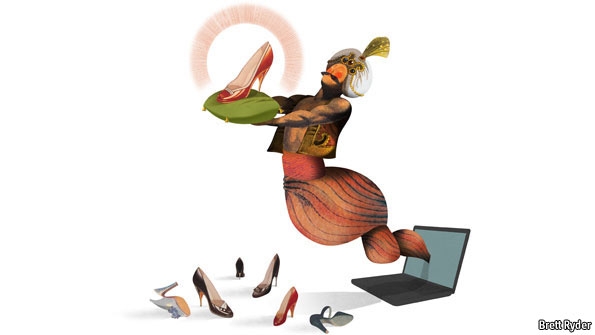 客户是上帝。为了能更好地服务上帝,一些公司开始设立“首席客户官(CCO)”这个新职位。这些新人们的职责是站在客户的角度审度公司运作,试图不再局限于单一个人的事务处理,而是把眼界拓宽到整体的“顾客体验”上。顺便,他们还把已经很挤的“C字一号房”弄得更挤了。
客户是上帝。为了能更好地服务上帝,一些公司开始设立“首席客户官(CCO)”这个新职位。这些新人们的职责是站在客户的角度审度公司运作,试图不再局限于单一个人的事务处理,而是把眼界拓宽到整体的“顾客体验”上。顺便,他们还把已经很挤的“C字一号房”弄得更挤了。
首席客户官有很多助手。Saleforce.com 派了名“终生客户副总裁”去打下手,数据存储公司NetApp有个“消费者利益代言副总裁”,科技巨头思科的是“客户倾听总监”,投资公司先锋集团派出的的则是“消费者之声团队”。
新书《外围攻陷》(Outside In)帮助解释了这一切的缘由。Forrester Research 咨询公司的Harley Manning 和 Kerry Bodine 观察到,客户们变得越来越重要了。互联网让货比三家更方便,同时也负面评价也传播得更快更广。但即使如此,差劲的服务依然比比皆是。今年,他们问及的160家公司中,有三分之一被评为“差”或“很差”,其中以健康保险公司和电缆公司尤甚。
愤怒的消费者们还能用他们的影响力改变大流。他们已经做出了选择,抛弃像AOL这样的“消费者不友好”品牌,转而投入尽心为他们服务的竞争对手的怀抱,比如说Zappos(一个可以让你无数次下单,试穿和退货的网上鞋店)和廉价但态度端正的西南航空。银行方面,Bank of America 估计会被他们几乎垫底的客户体验指数给吓到,USAA则荣居榜首。
有些公司不喜欢技术,认为他们和客户之间的关系会被技术搞砸,这时首席客户官也许能帮到他们。和大多数报社一样,华盛顿邮报发现相较于简单的日报版本,他们更有必要提供一个能提供稳定内容的系统。罗塞特石碑(一家语言学习软件公司)则发现他们还需要推出交互式学习指导。
这会改变什么吗?一直以来,公司们都在向消费者们放各种卫星,服务质量却还是一如既往的差。在此两位作者反驳道,公司的态度已经转向,它们开始向苹果和迪士尼这类掌握了消费者关系学密码的公司学习。这些公司在招聘员工时,不仅仅是看他们的技能,而更加着重于工作态度。
一种特有的服务文化也由此而生:举例来说,Zappos 维护着一个存有各种模范电话录音的“牛逼图书馆”,它们的员工可以随时收听;门房服务代理 Circles 则会给予顾客满意度较好的员工包括假期在内的各种奖励。
作者同时指出,在当下,公司能够了解消费者反馈的渠道比以往任何时候都要多。酒店集团 Accor 有专人研究客户留言,并把它们整理至30个类别。由此,管理者可以从客户身上汲取灵感,改进自身服务。
公司也在不断发展技术以改善服务。它们能够追踪消费者的“足迹”,如选购商品,付款或寻求帮助,找出它们在“旅途”中可能会遇到的问题。此外,根据不同的消费习惯,建立不同的消费模型也能够优化服务。Geek Squad,一家美国IT维修公司,把顾客分成了两类,一类是把电脑当做家用电器的Jill 型,另一种是喜欢研究技术的Daryl 型。公司对这两类顾客提供不同的服务,且欢迎他们的反馈。
办公耗材连锁Office Depot 在位于南佛罗里达总部的附近建立了一家概念店“货架实验室”。顾客可以参与设计“消费体验”,且越来越多的消费者正在参与其中。他们也耍出了让高层人员假扮成顾客的老伎俩。软件公司Adobe通过举办“顾客心连心日”让管理人员直面顾客,解决他们认为最麻烦的问题。
机器的崛起
以上所有听起来都很美,不过想要实行,对应的阻力也相当大。消费者都希望物美价廉,为了节约成本,“顾客体验”不得不做出牺牲。在超市,你需要自助结账;当你家的洗衣机或网络出了问题,你唯一的依靠只有远在海德拉巴的某位几乎不会说英语的小哥。老板们总是认为庞大的数据库能帮助他们更加深入地了解客户,其实却是加深了隔阂。
举例来说,在客服电话中,你几乎轮不到和真人讲话。首先,你得花上半个小时去找那费尽心机隐藏起来的客服电话。打过去后,接电话的是个机器人。有些人不胜其烦,干脆做了个网站,分享各种绕过录音机的小贴士。(笔者最喜欢的是扮成崩溃掉的中国人。译者注:这是高端黑吗亲...)不过如果你以为这些小伎俩能得逞,那你就图样图森破了。恰恰相反,为了让你更难接近人类,他们升级了机器,让它们能干些订票之类的高级活儿。真高端。
这些神一般的机器至少有一个用处:顾客们可由此看出这项新的管理风潮所能带来的价值。给那些设有“首席客户官”的公司打个电话吧,如果接电话的不是真人,这CCO 估计就得抓着他的“轨迹地图”和“客户原型”,被人从高管楼层的窗户扔出去了。
THE customer is king. So some firms have started appointing chief customer officers (CCOs) to serve the king more attentively. These new additions to the (already crowded) C-suite are supposed to look at the business from the customer’s point of view. They try to focus on the entire “customer experience”, rather than on individual transactions.
CCOs have many assistants. Salesforce.com has a “vice-president of customers-for-life” to help its CCO. NetApp, a data-storage firm, has a “vice-president of customer advocacy”. Cisco, a technology giant, has a “director of customer listening”. Vanguard, an investment firm, has a “voice of client group”.
A new book helps explain why this is happening. In “Outside In”, Harley Manning and Kerry Bodine of Forrester Research, a consultancy, observe that customers are growing more powerful. The internet makes it easier to shop around and share complaints with a wide audience. Yet poor service persists. Mr Manning and Ms Bodine have been asking customers about their experiences with American companies for years. In 2012 a third of the 160 firms they asked about were rated “poor” or “very poor”. Health insurers and cable companies fared worst.
Powerful, angry customers could spur big changes. Already, they have dumped customer-unfriendly brands, such as AOL, an internet portal, as soon as alternatives came along. They have embraced companies that serve them well, such as Zappos (an online shoe shop that lets you order, try on and return as many shoes as you like) and Southwest Airlines, a cheap but friendly carrier. Bank of America should be terrified that it is near the bottom of the customer-experience index while another bank, USAA, is right at the top.
Having a CCO may help firms that find that technology is disrupting the way they relate to their customers. The Washington Post (like most newspapers) has discovered that it must provide a constant stream of content rather than a single daily edition. Rosetta Stone, a provider of language-learning software, has found that it needs to offer interactive coaching as well. Both companies have recruited CCOs.
Will this make any difference? Companies have paid lip service to customer service for years, yet still treat customers like serfs. Mr Manning and Ms Bodine retort that companies are trying to learn from the few, such as Disney and Apple, that have cracked the customer-service code. These firms hire for attitude rather than skills alone. They nurture a culture of service. For example, Zappos keeps a “Wow Library” of exemplary recorded calls that its employees can listen to. Circles, a concierge service, gives employees prizes, including time off, for getting high scores on customer-satisfaction surveys.
The authors also point out that companies have more ways than ever before to find out what their customers think of them. Accor, a hotel company, pores over comments on websites and sorts them into 30 different categories. Its managers receive daily customer insights that help them identify and solve problems.
Companies also have a growing arsenal of techniques to improve customer service. They identify the “journeys” that customers take—such as choosing a product, paying for it or asking for help—and then follow them on their travels to see if they encounter any problems. They invent archetypes of different sorts of customers to fine-tune their services. For example, Geek Squad, an American firm that fixes IT problems, offers one kind of service to “Jill” (who regards her computer as a utility) and another to “Daryl” (a fellow geek who likes to chat about technology). The firm encourages customers to offer advice.
Office Depot, a business-supplies chain, has built a “planogram lab”—a prototypical store near its headquarters in south Florida. It brings in customers to help design its “shopping experience” and yet more customers to test it. It also uses the old trick of forcing senior managers to play the role of customers. Adobe, a software firm, holds “customer immersion days” where it exposes managers to what customers regard as the most infuriating problems they have to deal with.
The rise of the machines
All this sounds splendid, but there are powerful forces tugging in the other direction. Customers like low prices as well as good service, and many of the things companies can do to cut costs make the “customer experience” stink. Supermarkets make you check out your own groceries. When your washing machine or internet connection breaks down, the only help you can get is from a chap in Hyderabad who speaks little or no English. Bosses like to think that big data will help them understand their customers better. But often they use new technology to build barriers between themselves and the paying public.
It is, for example, almost impossible to call a company and talk to a human being. First you spend half an hour finding the carefully concealed telephone number. When you dial it, an android answers. Frustrated grumblers have set up websites with tips on how to get past the robo-gatekeepers. (Schumpeter’s favourite trick is to pretend to be a deranged Chinese-speaker.) You’d think companies would take the hint. Instead, they have made it even harder to reach a human and set the machines to work on more complicated tasks, such as selling tickets. Wow.
These infernal devices do at least perform one useful function: they let customers measure the value of this new management fad. Phone a firm that has appointed a chief customer officer and see if you can reach a human being. If not, that CCO might as well be tossed from an executive-floor window, no doubt clutching his collection of “journey maps” and “customer archetypes”.
 客户是上帝。为了能更好地服务上帝,一些公司开始设立“首席客户官(CCO)”这个新职位。这些新人们的职责是站在客户的角度审度公司运作,试图不再局限于单一个人的事务处理,而是把眼界拓宽到整体的“顾客体验”上。顺便,他们还把已经很挤的“C字一号房”弄得更挤了。
客户是上帝。为了能更好地服务上帝,一些公司开始设立“首席客户官(CCO)”这个新职位。这些新人们的职责是站在客户的角度审度公司运作,试图不再局限于单一个人的事务处理,而是把眼界拓宽到整体的“顾客体验”上。顺便,他们还把已经很挤的“C字一号房”弄得更挤了。
